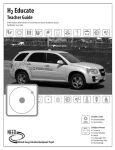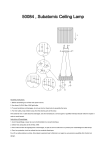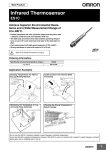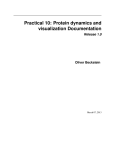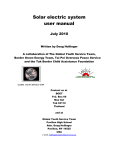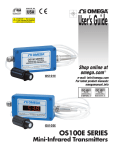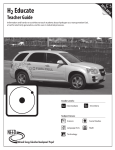Download Activity 7: Fuel Cell Simulation
Transcript
! Vocabulary anode atom catalyst cathode circuit electrode electrolysis electrolyte electron hydrogen ion membrane molecule oxygen PEM polymer Activity 7: Fuel Cell Simulation Objectives Students will be able to explain how hydrogen is used to carry energy and generate electricity. Students will be able to explain the components of a PEM fuel cell and how it works. Students will be able to trace the flow of the system of a PEM fuel cell by accurately drawing and labeling a diagram. Materials Flashing bulbs Flashlight Fringe Colored tape Scissors String Cardstock Fuel Cell master, Teacher Guide page 20 Fuel Cell Simulation, Teacher Guide page 21 Hang tag master, Teacher Guide page 22 Simulation Rubric, Teacher Guide page 15 Student Informational text, Student Guide page 10 What is a Fuel Cell? worksheet, Student Guide page 24 Simulation Suggestions Preparation 1. Students will need a 10’ x 10’ open space; use a hallway, outside area, or gym to allow enough room for movement and observers. Have the students set up the simulation according to the diagram. Write the vocabulary list on the left onto the board. 2. Let students determine how to conduct the simulation. Part of the learning value of this activity is allowing students to discover and learn by doing, extending, and reinforcing prior knowledge. 1. Have the students review the vocabulary terms using the Glossary in the Student Guide. Prepare a copy of the Fuel Cell master to project for the class. Make four copies of the hang tag master onto cardstock, cut out the hang tags and attach string to each tag. The hydrogen and oxygen hang tags are two-sided tags, folded on the dotted lines. Procedure 2. Use the Fuel Cell master to introduce the operation of a fuel cell to the students. 3. Have the students read the What is a Fuel Cell? section of the informational text and the What is a Fuel Cell? activity instructions. Answer any student questions. 4. Assign roles to the students. Some students may be observers during the first simulation, then assume roles in a second simulation while the other students observe. ;Assessment 1. After participating in and observing the simulation several times, have the students imagine they are writing to other students to explain how a fuel cell works, with an explanation of how fuel cells are used. Students must use the vocabulary words and draw diagrams to support their explanations. 2. Use the Simulation Rubric to assess vocabulary acquisition and understanding of concepts. 12 H2 Educate Teacher Guide MASTER Fuel Cell 20 H2 Educate Teacher Guide Fuel Cell Simulation Students (15) Representing The Following Roles PEM Simulation 4 Hydrogen atoms (H) 2 Oxygen atoms (O) 2 Anodes (A) 2 Cathodes (CA) 2 PEMs (P) 3 Circuit Members (C) Materials 4 Pieces of fringe (each six feet long) 4 Flashing bulbs 1 Flashlight 1 Piece of colored tape to make circuit on floor 1 Hang tag for each student Procedure 1. All students wear hang tags representing their roles. The Hydrogen hang tags have H on one side and H+ on the other. The Oxygen hang tags have O on one side and O– – on the other. 2. The two Anodes hold up two pieces of six-foot fringe forming a rectangle. The two Cathodes hold up two pieces of six-foot fringe forming a rectangle. 3. The two PEMs stand between the Anode and Cathode. 4. Two sets of two Hydrogens link arms to create two Hydrogen molecules on the outside of the Anode. Each Hydrogen carries a flashing bulb (turned off ) that represents its electron. 5. Two Oxygens link arms to create an Oxygen molecule on the outside of the Cathode. 6. The Hydrogens pass through the fringe into the Anode and separate into two Hydrogen atoms. 7. The Oxygens pass through the fringe into the Cathode and separate into two Oxygen atoms. 8. The Hydrogen atoms pass through the inner fringe. 9. The PEMs stop the Hydrogen atoms from moving. 10. The Hydrogen atoms hand their electrons to the first Circuit Member and turn their hang tags to H+ ions. 11. The PEMs allow the H+ ions to pass through to the Cathode. 12. The Circuit Member turns on the flashing bulbs and hands them to the middle Circuit Member, who turns on a flashlight as he/she receives the electrons and turns the flashlight off as he/she passes the electrons to the last Circuit Member. The last Circuit Member hands two electrons to each Oxygen atom in the Cathode, who turns the flashers off and switches his/her hang tag to Oxygen ion (O– –). 13. Two Hydrogen ions link arms with an Oxygen ion (with the Oxygen in the middle), turning their hang tags and forming a water molecule. The water molecules then exit the outside of the Cathode. ©2014 The NEED Project P.O. Box 10101, Manassas, VA 20108 1.800.875.5029 www.NEED.org 21 HANG TAG MASTER 22 H2 Educate Teacher Guide Assembly and Operation of the Fuel Cell Car The Fuel Cell Car should be used only by a knowledgeable teacher or by students under the supervision of the teacher. The teacher must ensure proper handling and draw attention to potential dangers. Before using the car, review the User Manual in the car kit to fully understand operational safety precautions. All participants should wear safety glasses. The car should be assembled and operated on a solid, level surface, with the ambient temperature between 20°C and 30°C. It is recommended that you operate the car indoors to protect it from the weather. Make sure that the Fuel Cell Car is not charged or operated near an open flame. Basic Function Here are the basics of how the fuel cell works. Refer to the User Manual for additional technical data. 1. Use ONLY THE POWER SUPPLY INCLUDED to provide the electricity to power the electrolysis process. 2. The electric current splits the water molecules into hydrogen and oxygen gases in the charge mode of the reversible fuel cell. The gases are stored in the storage cylinders. 3. In the discharge mode, the fuel cell uses the hydrogen and oxygen gases as fuel to generate an electric current that runs the electric motor of the car, producing water and heat as byproducts. Assembly of the Fuel Cell Car MATERIALS: Fuel Cell Car Kit with User Manual, 2 AA batteries (3-volt maximum), scissors, distilled water 1. Follow the instructions on pages 6–7 of the User Manual to assemble the car. 2. To HYDRATE the fuel cell, follow the instructions on page 7 of the User Manual. CAUTION: Only distilled water should be used. Use of any other liquid, even tap water, may destroy the fuel cell membrane. Electrolysis: Producing Hydrogen MATERIALS: Assembled Fuel Cell Car, power pack with 2 AA batteries, distilled water 1. Follow the instructions on pages 8-11 of the User Manual to produce hydrogen using the fuel cell. 2. Use ONLY the power pack provided. 3. Use ONLY distilled water. 4. DO NOT PROCEED near an open flame. 5. DO NOT PROCEED until you have hydrated the fuel cell as explained in the assembly section above. Operation of the Fuel Cell Car MATERIALS: Charged Fuel Cell Car 1. Follow the instructions on page 12 of the User Manual to operate the Fuel Cell Car. 2. When the car stops running, it can be recharged following the Electrolysis Procedure. 3. The AA batteries in the power pack may need to be replaced after several charges. Advice and Troubleshooting 1. Follow the advice on page 13 of the User Manual for optimal operation. 2. Use the Troubleshooting section on page 14 of the User Manual if your car does not work properly. ©2014 The NEED Project P.O. Box 10101, Manassas, VA 20108 1.800.875.5029 www.NEED.org 23 Hydrogen in the Round I have Hydrogen. I have Electron. I have Element. I have Energy Level. 1. Who has the name of an area around the 1. Who has a name for a substance in which all of nucleus of an atom where an electron is most the atoms are identical? likely to be found? 2. Who has an experimental method of producing 2. Who has a device like a battery that uses an hydrogen using a semiconductor to absorb external source of fuel to produce electricity, and sunlight? releases water and thermal energy? 1. Who has the positively charged subatomic particle in the nucleus of an atom? 2. Who has a method of producing hydrogen gas from biomass? 1. Who has the form of energy that travels in electromagnetic waves? 2. Who has a battery or fuel cell that generates electricity through a chemical reaction? I have Proton. I have Radiant Energy. 1. Who has the neutral subatomic particle in the nucleus of an atom? 2. Who has an experimental process to produce hydrogen using bacteria and algae? 1. Who has the process that releases energy in the core of the sun? 2. Who has a closed loop that carries electrical energy? I have Neutron. I have Nuclear Fusion. 1. Who has the subatomic particle that moves outside the nucleus of an atom? 2. Who has the term for a substance that moves energy and sometimes requires another energy source to create it? 24 1. Who has the process that uses steam to split methane molecules to produce hydrogen and oxygen? 2. Who has a membrane that allows hydrogen ions to pass through, but not electrons? H2 Educate Teacher Guide Hydrogen in the Round I have Steam Reforming. 1. Who has the process that uses moving electrons to split water into hydrogen and oxygen? 2. Who has the side of a PEM fuel cell through which hydrogen fuel enters? I have Photobiological Production. 1. Who has a substance or system that moves energy in a usable form from one place to another? 2. Who has the chemical bond usually found between metals and nonmetals? I have Energy Carrier. I have Electrolysis. 1. Who has the method of using sunlight to split water into hydrogen and oxygen? 2. Who has the special material that splits hydrogen gas into hydrogen ions and electrons? 1. Who has a device that uses hydrogen fuel to produce electricity, water, and heat? 2. Who has the chemical bond that occurs between nonmetals such as hydrogen and oxygen? I have Photoelectrolysis. I have Fuel Cell. 1. Who has the method of producing hydrogen by superheating wood and agricultural waste? 2. Who has the side of a fuel cell with the channels to distribute oxygen to the catalyst? 1. Who has a device that produces electricity through a chemical reaction? 2. Who has the ability to make a change in temperature, position, size, or state of matter? I have Biomass Gasification. I have Electrochemical Energy Conversion Device. 1. Who has the process by which algae and 1. Who has a path through which electricity bacteria use sunlight to produce hydrogen? travels? 2. Who has the name of the particle formed when 2. Who has coal, natural gas, petroleum, propane, an atom loses or gains electrons? and uranium? ©2014 The NEED Project P.O. Box 10101, Manassas, VA 20108 1.800.875.5029 www.NEED.org 25 Hydrogen in the Round I have Circuit. I have Cathode. I have PEM. I have Ion. I have Anode. I have Ionic Bond. I have Catalyst. I have Covalent Bond. 1. Who has a short name for Polymer Electrolyte 1. Who has an atom or group of atoms that have Membrane? an electrical charge? 2. Who has wind, solar, geothermal, hydropower, 2. Who has the substances organized in the and biomass? Periodic Table? 1. Who has the attraction or bond between two 1. Who has the negative side of a fuel cell? oppositely charged ions? 2. Who has a chemical reaction that draws energy 2. Who has the subatomic particle in the nucleus in from its surroundings? that determines atomic number? 1. Who has a substance that speeds up a reaction, 1. Who has the chemical bond in which two without being consumed in the reaction, such as atoms share electrons? in a fuel cell? 2. Who has the subatomic particle with which 2. Who has a method for reducing greenhouse the strong nuclear force is associated, and which gases produced by fossil fuel combustion and helps hold the nucleus together? steam reformation? 1. Who has the positive side of a fuel cell? 2. Who has the system of organizing all of the known elements? 26 1. Who has the ability to do work? 2. Who has the subatomic particle that carries a negative charge? H2 Educate Teacher Guide Hydrogen in the Round I have Energy. I have Endothermic. 1. Who has energy sources that are limited and cannot be replenished in a short time? 2. Who has the name of the area at a precise distance where the electrons are held in an atom? 1. Who has the name for the trapping, storage, and use of carbon gases? 2. Who has the most cost effective method of producing hydrogen fuel today? I have Nonrenewable. I have Carbon Capture, Utilization, and Storage. 1. Who has energy sources that are unlimited or can be replenished in a short period of time? 2. Who has the form of energy that comes from the sun and powers photosynthesis? I have Renewable. 1. Who has the arrangement of elements by their physical and chemical properties? 2. Who has a simple method of using electricity to produce very pure hydrogen? I have Periodic Table. 1. Who has a chemical reaction that absorbs 1. Who has an abundant, clean, domestically energy? available, flexible fuel? 2. Who has the process that combines very small 2. Who has a clean fuel that can be produced by atoms into larger atoms, releasing vast amounts of steam reforming and electrolysis? radiant energy? ©2014 The NEED Project P.O. Box 10101, Manassas, VA 20108 1.800.875.5029 www.NEED.org 27 Pre/Post Hydrogen Survey 1. The average American uses how much energy compared to the average world citizen? a. half as much b. twice as much c. four times as much d. twenty times as much 2. What percentage of U.S. energy consumption is from renewable energy sources? a. less than 10% b. 11-20% c. 21-40% d. more than 40% 3. About how much of total crude oil supply does the United States import from foreign countries? a. 5-10% b. 30-35% c. 45-50% d. 75-80% 4. How much of total U.S. energy consumption is used by the transportation sector of the economy? a. 8% b. 18% c. 28% d. 48% 5. An ideal energy system would ____________ a. include domestic and imported energy sources. b. use only nonrenewable energy sources. c. use a variety of energy sources. d. All of the above. 6. Hydrogen is one of the most abundant elements in the universe. True False 7. Hydrogen gas is abundant in underground reservoirs on Earth. True False 8. Hydrogen fuel can be produced from __________ a. water. b. natural gas. c. biomass. d. All three. 9. Hydrogen can be used ____________ a. as a vehicle fuel. b. to produce electricity. c. Both a and b. d. Neither a nor b. 10. Electrolysis is a process in which electricity is used to ____________ a. turn water into steam. b. combine hydrogen and oxygen molecules to make water. c. split water molecules into hydrogen and oxygen gases. d. produce light and heat. 11. A fuel cell ____________ a. produces electricity. b. uses hydrogen as fuel. c. emits only water and heat. d. All of the above. 12. A fuel cell must be replaced often, like a non-rechargeable battery. True False 13. Hydrogen can be transported as a liquid or a gas. True False 14. Hydrogen is as safe as gasoline or diesel fuel when handled properly. True False 15. Hydrogen could meet many of our energy needs in the future. True False 28 H2 Educate Teacher Guide










